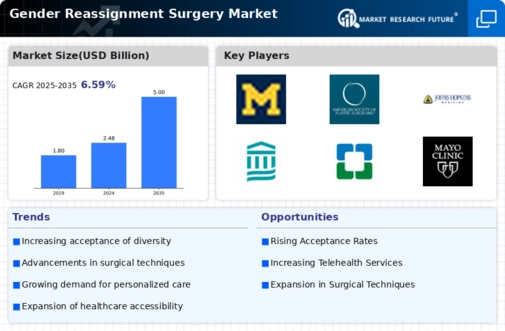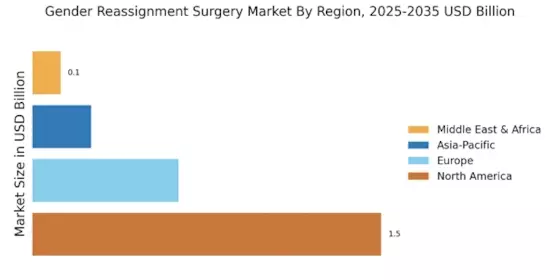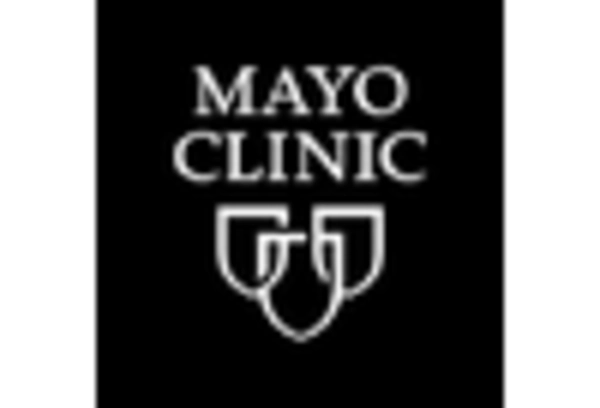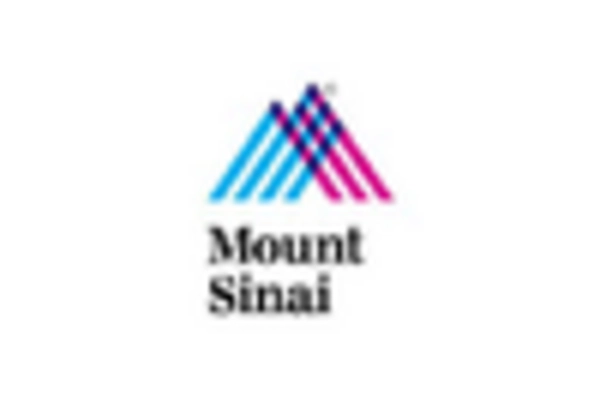Growing Mental Health Awareness
The growing awareness of mental health issues related to gender dysphoria is a significant driver in the Gender Reassignment Surgery Market. Mental health professionals increasingly recognize the importance of gender-affirming surgeries as a means to alleviate psychological distress among transgender individuals. Research indicates that access to these surgeries can lead to improved mental health outcomes, including reduced rates of anxiety and depression. As mental health advocacy continues to gain traction, more individuals are encouraged to seek surgical options as part of their overall treatment plan. This trend is likely to enhance the visibility and acceptance of the Gender Reassignment Surgery Market, fostering an environment where individuals feel empowered to pursue necessary medical interventions.
Increased Demand for Gender Affirmation
The rising demand for gender affirmation procedures is a pivotal driver in the Gender Reassignment Surgery Market. As societal acceptance of diverse gender identities continues to grow, more individuals are seeking surgical options to align their physical appearance with their gender identity. This trend is reflected in the increasing number of surgeries performed annually, with estimates suggesting that the market could reach a valuation of several billion dollars by the end of the decade. The heightened visibility of transgender issues in media and public discourse has also contributed to this demand, encouraging individuals to pursue surgeries that were once stigmatized. Consequently, healthcare providers are expanding their services to meet this growing need, thereby propelling the Gender Reassignment Surgery Market forward.
Supportive Legislation and Healthcare Policies
Supportive legislation and evolving healthcare policies are crucial drivers in the Gender Reassignment Surgery Market. Many countries are increasingly recognizing the rights of transgender individuals, leading to the implementation of laws that mandate insurance coverage for gender-affirming surgeries. This shift not only alleviates the financial burden on patients but also legitimizes the necessity of these procedures within the healthcare system. Recent data suggests that regions with comprehensive healthcare policies see a higher rate of surgeries performed, indicating a direct correlation between policy support and market growth. As more jurisdictions adopt similar measures, the Gender Reassignment Surgery Market is poised for substantial expansion.
Technological Innovations in Surgical Procedures
Technological advancements in surgical techniques are significantly influencing the Gender Reassignment Surgery Market. Innovations such as minimally invasive procedures, enhanced imaging technologies, and robotic-assisted surgeries are improving patient outcomes and reducing recovery times. These advancements not only enhance the precision of surgeries but also increase the safety profile, making procedures more appealing to potential patients. Data indicates that hospitals adopting these technologies have reported higher patient satisfaction rates, which is crucial in a market where emotional and psychological factors play a significant role. As these technologies become more widely available, they are likely to attract a broader demographic, further stimulating growth in the Gender Reassignment Surgery Market.
Increased Accessibility through Telehealth Services
The rise of telehealth services is transforming the accessibility of gender reassignment surgeries, acting as a vital driver in the Gender Reassignment Surgery Market. Telehealth platforms enable patients to consult with specialists from the comfort of their homes, reducing geographical barriers and facilitating access to care. This is particularly beneficial for individuals in remote areas who may have limited access to healthcare facilities offering gender-affirming surgeries. Data suggests that telehealth consultations have increased significantly, allowing for better pre-operative assessments and follow-up care. As telehealth continues to evolve, it is expected to play a crucial role in expanding the reach of the Gender Reassignment Surgery Market, making these essential services more accessible to a wider audience.


















Leave a Comment